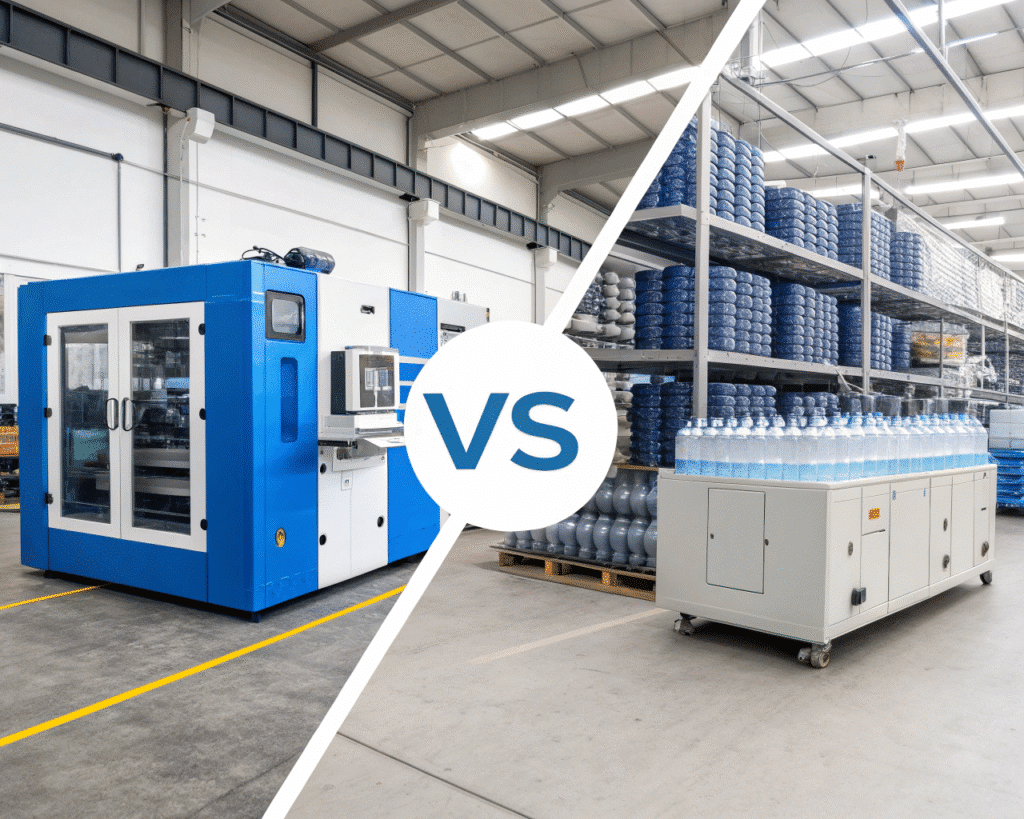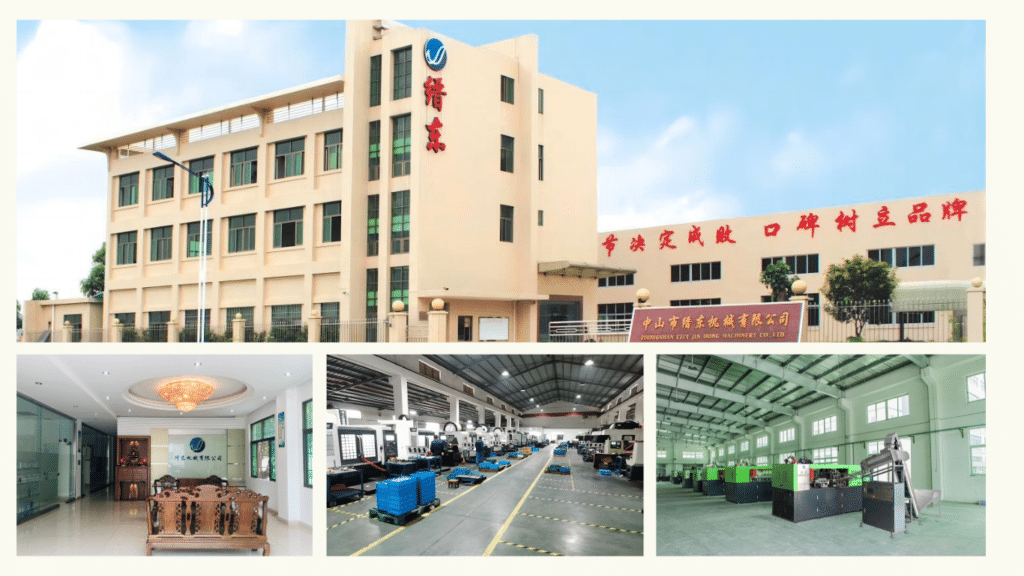Your brand is growing, but bottle supply is a constant headache. Do you keep buying from others, or take the plunge and make them yourself? The choice is a major turning point.
Deciding between in-house production and outsourcing bottles is a critical strategic choice. In-house offers control and long-term cost savings once you achieve scale. Outsourcing provides a low-cost entry point but comes with dependencies on suppliers for quality, lead times, and flexibility for new product testing.

This decision can feel overwhelming. I've seen it firsthand in my 16 years in the PET packaging industry. It's a question that pits immediate financial reality against long-term strategic goals. But it's not a decision you have to make in the dark. I've helped over 30 brands navigate this exact crossroad, and I'm going to walk you through the key pain points to help you find the right answer for your business. Let's break it down together.
The Great Investment Divide: Visible Machine Costs vs. 'Zero-Barrier' Outsourcing?
Starting a new brand is tough, and cash is always tight. You look at outsourcing bottles and see a simple, predictable expense. Then you look at a production line and see a mountain of costs.
The huge upfront cost of an in-house production line is the single biggest barrier for startups. In contrast, outsourcing seems to have no entry fee, allowing you to start with minimal capital and pay as you go, which is very attractive when funds are limited.
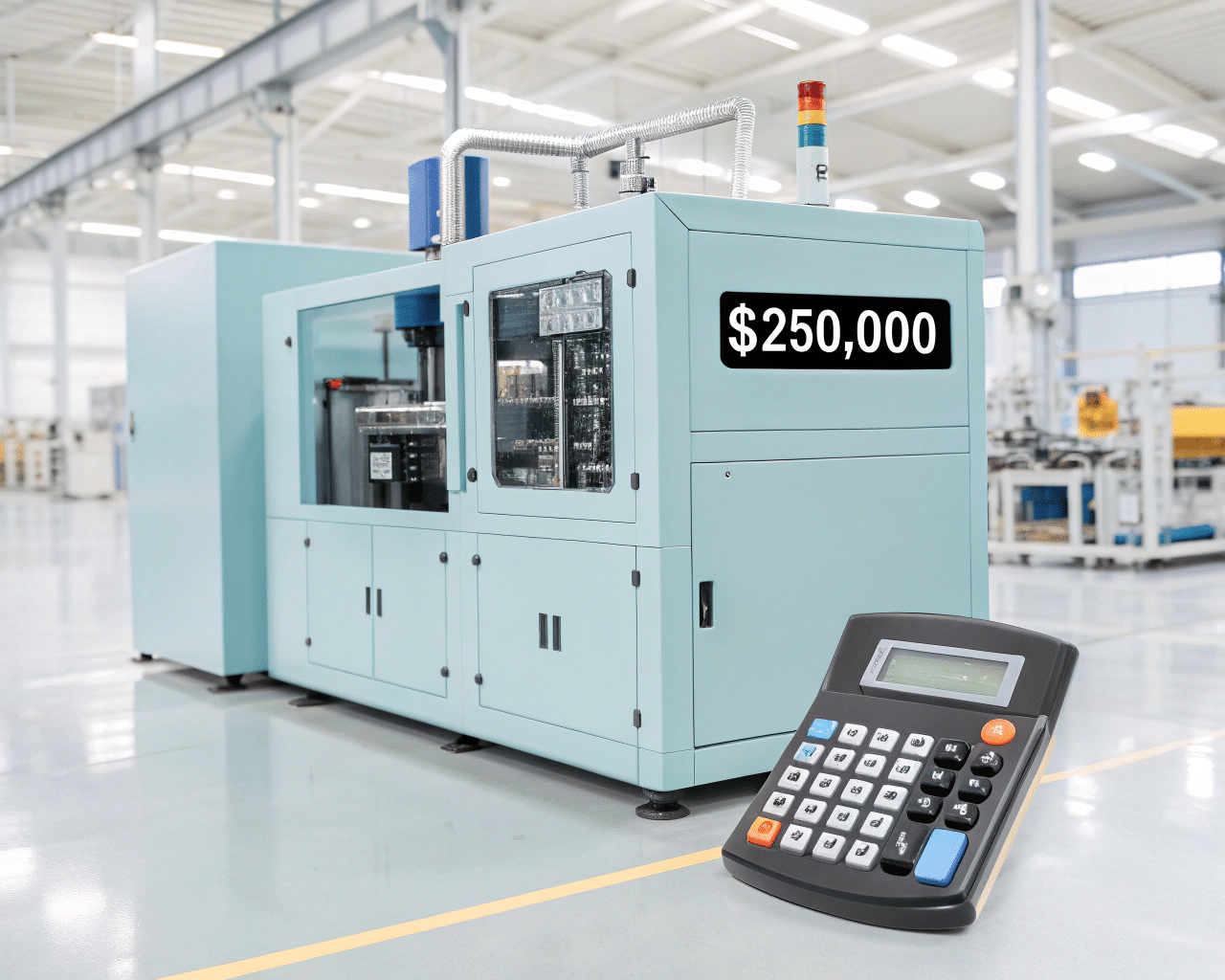
Dive Deeper: The Reality of Upfront Capital
Let's be very direct about the initial investment. When you decide to bring production in-house, you are not just buying one machine. You are investing in a complete manufacturing ecosystem. I always make sure my clients understand the full picture from day one. It's about transparency.
In-House Startup Costs Breakdown
The centerpiece is, of course, the bottle blowing machine. The price of these can vary dramatically based on speed, cavitation (how many bottles it makes at once), and level of automation. But the costs don't stop there. Here’s a more realistic look at what you need to budget for:
- Blow Molds: You need at least one blow bottle mold for each bottle design you plan to produce. Complex designs or multi-cavity molds increase this cost. This is a critical piece of your brand's physical identity.
- Auxiliary Equipment: Your blowing machine is useless on its own. It needs a support system. This includes a high-pressure air compressor system to form the bottles, and a chiller to cool the molds, which is essential for bottle quality and production speed. You also need air dryers and filters.
- Factory Modifications: You need a suitable space. This might involve new electrical wiring for heavy machinery, plumbing for the chiller, and reinforced concrete flooring. Ventilation is also a key consideration. I've walked through many empty warehouses with clients, helping them plan the layout for efficient workflow.
- Preforms and Raw Materials: You need an initial stock of PET preforms. Choosing the right one is a science in itself, which is why I created a guide on selecting the right preform neck size. This is working capital, but it's cash you need to have on hand.
- Installation and Training: The equipment needs to be professionally installed and calibrated. More importantly, your team needs to be trained to operate and maintain it. This is a service I am deeply involved in, like with my recent project for a 12,000 BPH water line in Thailand, where we handled the complete turnkey service from planning to final commissioning.
Here is a simple table to illustrate the stark contrast in initial financial commitment.
| Cost Component | In-House Production (Estimate) | Outsourcing Bottles |
|---|---|---|
| Machinery Investment | $50,000 - $500,000+ | $0 |
| Molds | $5,000 - $25,000 per design | $0 (or a one-time fee) |
| Auxiliary Equipment | $20,000 - $100,000+ | $0 |
| Factory Setup | $10,000 - $50,000+ | $0 |
| First Raw Material Order | $5,000 - $20,000+ | $0 (part of unit cost) |
| Total Initial Outlay | $90,000 - $700,000+ | $0 |
When you see the numbers laid out like this, the appeal of outsourcing is obvious for a cash-strapped startup. You avoid a massive capital expenditure and convert a fixed asset cost into a variable operating expense. You simply pay for the bottles you need, when you need them. This "zero-barrier" entry allows you to focus your precious startup capital on product development, marketing, and distribution, which are the engines of early growth.
The Long-Term Battle of Per-Bottle Cost: How Does Scale Determine Your Final Profit Margin?
You're paying a fixed price per bottle from your supplier, which feels safe. But as your sales grow, you notice your profit margin isn't improving. You're selling more but not necessarily earning more on each unit.
Outsourcing locks you into a relatively fixed per-unit cost, limiting your profit potential as you scale. In-house production has high initial costs, but once you surpass the break-even volume, the per-bottle cost drops significantly, leading to much higher long-term profit margins.
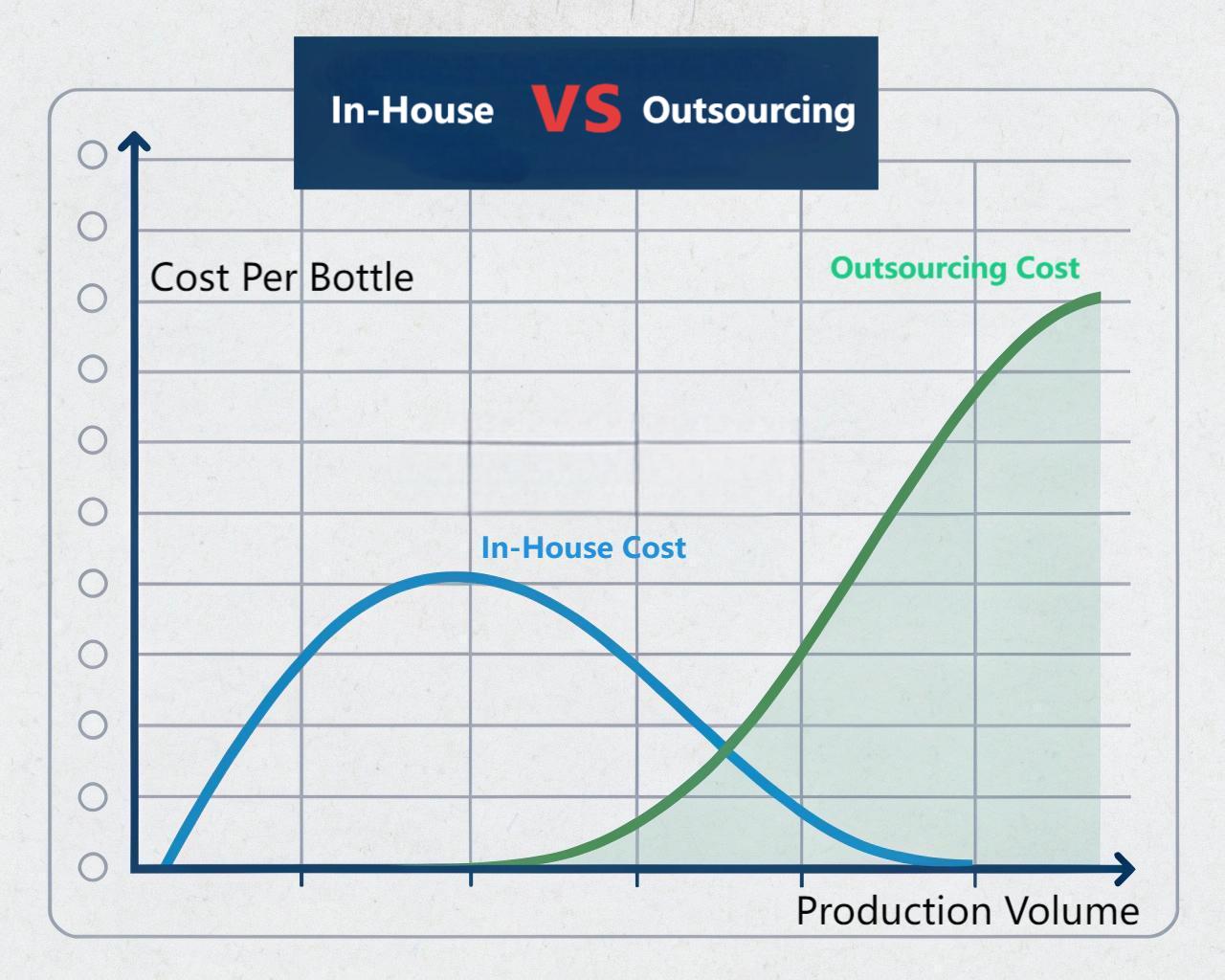
Dive Deeper: The Power of Economies of Scale
This is the long-term game. The decision you make today will directly impact your company's profitability in two, three, or five years. While outsourcing wins on day one, in-house manufacturing is built to win in the long run, but only if you have the volume.
Understanding Your Break-Even Point
The "break-even point" is the magic number. It's the production volume at which the cost of making a bottle yourself becomes equal to the cost of buying it from a supplier. Below this volume, outsourcing is cheaper. Above this volume, making it yourself becomes progressively more profitable.
Let's illustrate this. Suppose you can buy a bottle for $0.15 from a supplier.
To make it in-house, you have fixed costs (loan payments on the machine, factory space, operator salary) and variable costs (preforms, electricity).
- Outsourced Cost: A straight line. 100,000 bottles cost $15,000. 1,000,000 bottles cost $150,000. The cost per bottle is always $0.15.
- In-House Cost: A curve. Your first bottle might cost thousands of dollars when you factor in the fixed costs. But as you produce more, those fixed costs are spread across more units. The cost per bottle drops sharply.
I always advise my clients based on their real-world volume. Just last year, a client in Bangladesh told me his brand uses about 30,000 bottles a month. At that volume, the math is simple. I told him directly, "For now, keep outsourcing. Your volume doesn't justify the investment in a full production line." He was relieved by the honest advice.
In stark contrast, my client in Thailand is producing 12,000 bottles per hour. At that scale, the per-bottle cost for in-house production is a tiny fraction of what they would pay to an outside supplier. Their bottle production cost is so low that it becomes a major competitive advantage in their market.
Here’s how the profitability shifts with scale:
| Metric | Low Volume (e.g., 50k bottles/month) | High Volume (e.g., 1M bottles/month) |
|---|---|---|
| Outsourced Cost per Bottle | $0.15 | $0.14 (maybe a small discount) |
| In-House Cost per Bottle | $0.35 (high due to fixed costs) | $0.07 (fixed costs are spread thin) |
| Advantage | Outsourcing | In-House Production |
This make vs buy analysis isn't just an accounting exercise; it's a strategic forecast of your future profitability. If your brand has the ambition and potential to reach high volumes, the initial pain of investment transforms into the long-term gain of a higher profit margin on every single bottle you sell.
The Tyranny of MOQ: Is Outsourcing Killing Your Product Innovation and Market Testing?
You have a brilliant idea for a new seasonal flavor or a limited edition bottle. You call your supplier, excited, only to be told the minimum order is 100,000 units. Your great idea dies instantly.
The high Minimum Order Quantities (MOQs) required by most bottle suppliers make it incredibly expensive and risky to launch new products or test market demand. This rigidity effectively stifles the agility and innovation that are crucial for a startup brand's survival and growth.
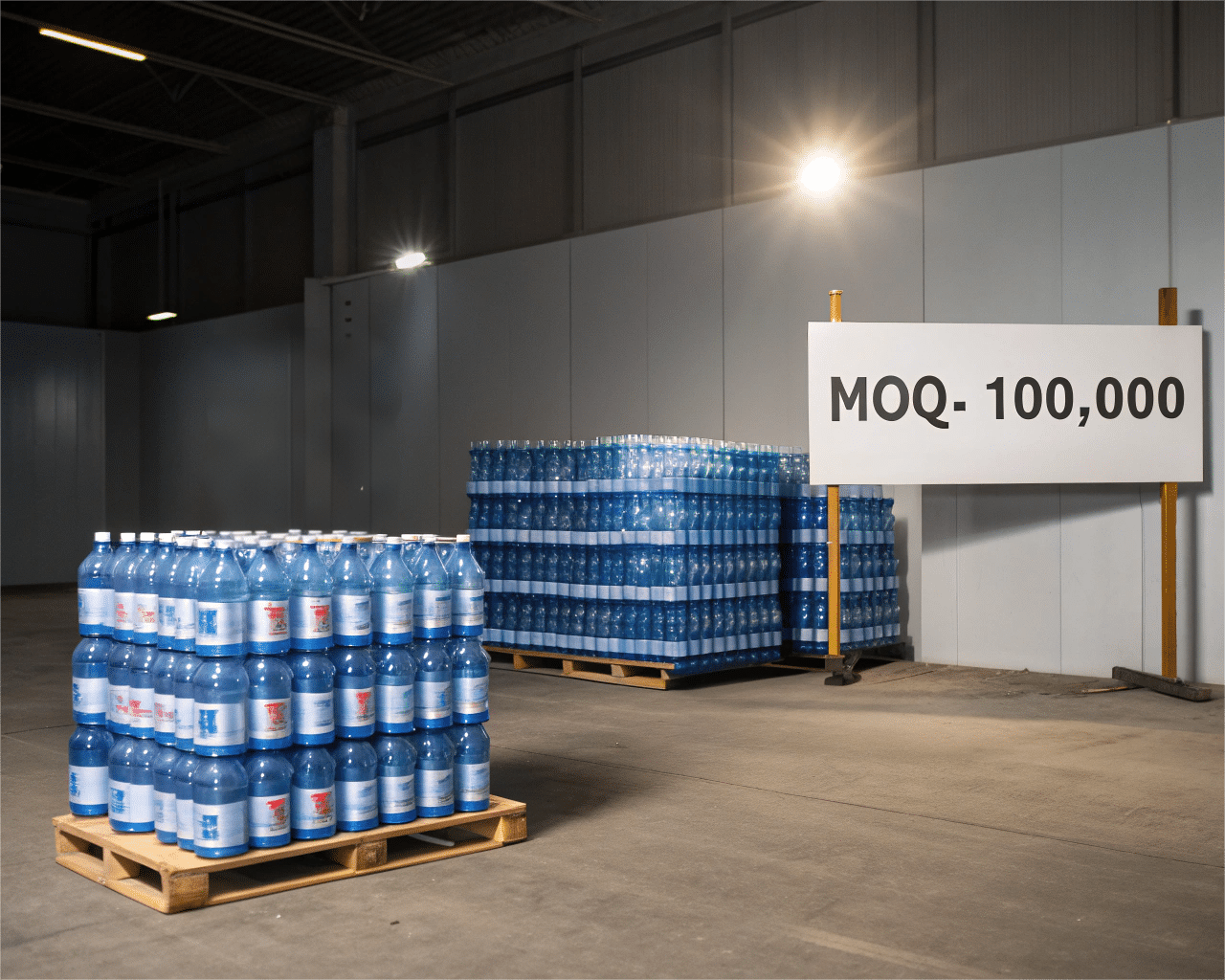
Dive Deeper: Agility is Your Superpower
For a startup, speed and flexibility are everything. You need to be able to react to market trends, test new ideas, and get products on shelves faster than your larger, more established competitors. This is where the outsourcing model often fails spectacularly.
The True Cost of High MOQs
A supplier's MOQ isn't an arbitrary number. It's the minimum run they need to make their own production process efficient and profitable. But their efficiency becomes your prison.
Imagine you're a craft beverage startup. You want to test three new flavors for the summer.
- Supplier's MOQ: 50,000 bottles per flavor.
- Your Test Run: You need 5,000 bottles of each to get feedback from a few key retailers.
- The Gap: The supplier requires you to order 150,000 bottles (50,000 x 3) for a test that only requires 15,000.
This situation forces you into a terrible choice:
- Scrap the idea: The most common outcome. Innovation dies.
- Bet the farm: Order the full 150,000 bottles and pray they sell. This is a massive cash outlay and a huge inventory risk. If a flavor is a dud, you're stuck with tens of thousands of useless bottles and wasted product.
This is a pain point I hear about constantly. Brands feel trapped. Their creativity is held hostage by the production realities of a third party.
In-house production completely flips the script. Your factory, your rules. If you want to run 2,000 bottles of a new pineapple-chili soda, you can. All it takes is scheduling a short production run. The key is having control over your tooling. Once you have your own blow bottle mold, you can produce as many or as few bottles as you need.
This agility is a game-changer for product development. You can follow a modern "lean startup" approach:
- Design: Develop a new concept. A great PET bottle mold design guide can help you create something unique.
- Validate: We can even help you create 3D printed samples to see and feel the bottle before committing to a full production mold.
- Test: Run a small batch of a few thousand units.
- Learn: Get real-world feedback from actual customers and retailers.
- Iterate: If the test is successful, scale up production. If not, tweak the recipe or design with minimal loss.
This ability to "fail small" is crucial. It allows you to take more risks and innovate faster because the cost of failure is a few thousand bottles, not a warehouse full of them. An in-house production line gives you this freedom. It turns your manufacturing from a constraint into a competitive advantage.
Losing Control: Is Your Brand's Quality in Someone Else's Hands?
You work hard to perfect your product and build your brand image. But when a customer picks up your bottle, the first thing they feel is a flimsy, cheap-feeling container with a weird tint. Your brand's reputation is instantly damaged.
When you outsource, you delegate the final quality of your packaging to a third party. You lose direct oversight over critical details like color, clarity, wall thickness, and defects, putting your hard-earned brand image and customer perception at risk with every batch.
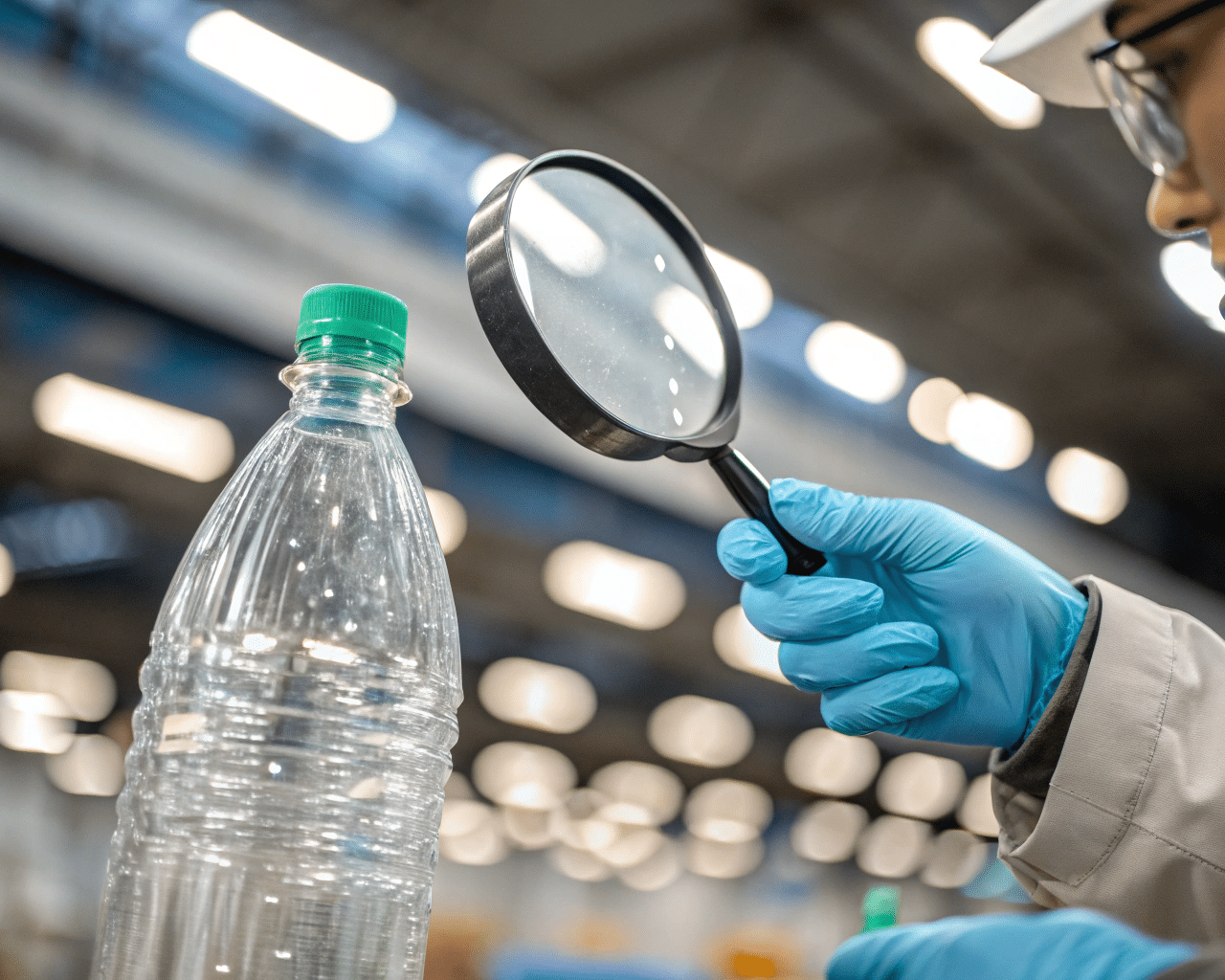
Dive Deeper: Your Bottle is Your Brand's Handshake
Never underestimate the power of packaging. For a physical product, the bottle is the brand before the customer ever tastes what's inside. It communicates quality, professionalism, and trustworthiness. When you give up control of its production, you're letting someone else speak for your brand.
Over my 16 years, I’ve seen how small inconsistencies can create big problems. I once had a beverage client who outsourced their bottles. They had a very specific, vibrant brand color. For one shipment, the supplier delivered 100,000 bottles where the PET material had a slightly yellowish tint. On its own, it was barely noticeable. But on the shelf next to the previous batch, the color difference was glaring. It made the new stock look old and cheap, and it completely disrupted their shelf presence. They had to reject the entire shipment, causing a major stock-out.
Key Quality Checkpoints You Can't Oversee
When the factory is hundreds or thousands of miles away, you lose the ability to walk the floor and check on these critical quality attributes:
- Weight and Wall Thickness: Is the bottle flimsy? Does the wall thickness feel consistent? A bottle that's too thin can feel cheap and may even deform during shipping or on the shelf.
- Color Consistency: As in my client's story, ensuring the color is identical from batch to batch is vital for brand consistency.
- Clarity and Haze: For clear bottles, like those for water, any haziness or cloudiness can make the product inside look impure.
- Material Purity: Are they using 100% virgin PET, or are they mixing in lower-grade recycled content that could compromise the bottle's integrity or appearance?
- Defect Rate: What is their tolerance for small defects? You might be paying for bottles with black specks, streaks, or small bubbles that you would never approve of if you saw them coming off your own line.
In-house production means you have absolute production control. You set the quality standard. You and your team are the final inspectors. If a batch isn't perfect, you can stop the line, diagnose the issue, and fix it immediately. This is why understanding how to fix problems is so important. I often share a guide on common PET blow molding defects with my clients' new teams so they can become self-sufficient quality guardians.
This level of brand control is priceless. It ensures that every single bottle that reaches the customer perfectly represents the quality and care you put into the product inside. It's about owning your brand's first impression, every single time.
Supply Chain Vulnerability: Are Long Lead Times Threatening Your Cash Flow & Customer Trust?
You just landed a huge order from a national retailer. It's the big break you've been working for. You call your bottle supplier to place the order, and they tell you the lead time is 12 weeks. Your delivery deadline is in 8. Panic sets in.
Outsourcing bottles often involves long and unpredictable lead times for production and shipping. This uncertainty creates significant supply chain risk management challenges, tying up your cash in inventory and jeopardizing your ability to meet customer commitments, which can destroy trust and future opportunities.

Dive Deeper: The Hidden Costs of Waiting
For a growing business, cash flow is oxygen. Long lead times slowly suffocate your business by trapping your money in a state of limbo.
Think about the typical outsourcing timeline:
- Place Order & Deposit: You place a large order and often have to pay 30-50% upfront. Your cash is gone.
- Production Queue: Your order waits in line behind the supplier's other customers. (2-4 weeks)
- Production Run: Your bottles are finally manufactured. (1-2 weeks)
- Ocean Freight: The bottles are loaded onto a container and shipped. This is the most unpredictable part. (4-6 weeks)
- Customs & Inland Freight: The container arrives, clears customs, and is trucked to your facility. (1-2 weeks)
Total Lead Time: 8 to 14 weeks, if everything goes perfectly.
During these 2-3 months, your money is tied up in bottles you can't use. But the problems are bigger than just cash flow.
The Ripple Effect of a Delayed Shipment
Let's go back to that dream order from a big retailer. A 12-week lead time is a deal-breaker. A delay means you fail to deliver on your promise. The consequences are catastrophic for a startup:
- Cancelled Order: The retailer will likely cancel the purchase order. You lose the sale and the revenue.
- Damaged Reputation: You are now seen as an unreliable supplier. That retailer may never give you a second chance.
- Lost Momentum: A big launch is all about momentum. A stock-out kills it. You lose shelf space, customer trial, and marketing buzz.
I saw this happen to a promising juice company. They were getting popular, and a regional grocery chain wanted to feature them in a promotion. Their bottle shipment was delayed by a storm and stuck at port for three extra weeks. They missed the promotional window. The grocery chain replaced them with a competitor. The brand never fully recovered from that lost opportunity.
In-house production crushes this vulnerability. It allows for "just-in-time" manufacturing. When you get a big order, you can start producing bottles the very next day. Your supply chain is shortened from three months to three days.
This is the kind of agility my Thai client now enjoys. With their 12,000 BPH line, they can respond to surges in market demand almost instantly. If a competitor has a supply issue, my client can ramp up production and fill that gap, capturing market share. Their in-house blow molding capability is not just a factory; it's a powerful weapon in their market. It gives them control over their destiny, their cash flow, and their promises to their customers.
The "Invisible" Technical Barrier: Are You Truly Ready to Become a Manufacturer?
Buying the machines feels like the biggest step. But then the equipment arrives. You're faced with complex controls, technical manuals, and the reality that you now own a factory. Are you ready for the operational challenges?
Bringing production in-house means you're no longer just a beverage brand; you're also a manufacturer. This requires technical expertise, skilled labor, and operational discipline that many startups are not prepared for, creating a significant but often overlooked barrier to success.

Dive Deeper: What 'Becoming a Manufacturer' Really Means
This is the point where I have a very honest conversation with my clients. I need to be sure they are ready for the shift in mindset. It's one thing to have a great product and brand; it's another thing entirely to manage the day-to-day reality of making your own packaging. It's not just about pushing a "start" button.
The People, Processes, and Parts
Becoming a manufacturing for startups success story involves mastering three key areas:
-
Technical Expertise: A bottle blowing machine is a sophisticated piece of equipment. Operating it effectively requires understanding things like heating temperatures, pre-blow and high-blow pressures, and stretch rod speeds. If a bottle has a defect, you need the knowledge to diagnose the root cause. Is the preform too hot? Is the pressure too low? This is why having resources on hand, like a guide to fixing common PET blowing defects, is so important for a new team.
-
Skilled Operations & Maintenance: You need to hire and train people. An experienced operator is worth their weight in gold. They can optimize machine settings for speed and quality, and they can spot problems before they become serious. You also need a rigorous maintenance schedule. These are industrial machines that need regular care—lubrication, filter changes, and inspections—to run reliably.
-
Managing the Ecosystem: As we discussed before, the blowing machine doesn't work alone. You have to manage the entire ecosystem.
- Is the chiller providing water at the correct temperature and flow rate? If not, your bottle quality will suffer.
- Is the air compressor system delivering clean, dry, high-pressure air consistently? Any drop in pressure can halt production.
- Are you managing your inventory of preforms and spare parts effectively?
This is precisely why my company's role often goes far beyond just selling equipment. For my clients, especially those new to manufacturing, we provide a turnkey, one-stop service. With the project in Thailand, we didn't just ship the machines. We designed the plant layout, installed every piece of equipment, and, most importantly, we stayed on-site to train their new team until they were confident and competent. We bridge that "invisible" technical gap. I also help them with things they might not even think about, like ensuring their new blow bottle mold will actually fit their machine, which is a common fear we address by having the mounting dimensions for most machines worldwide.
The question you have to ask yourself is: Do I have the passion and willingness to learn this new side of the business? If the answer is yes, the rewards are immense. If the answer is no, then outsourcing might be the wiser path, at least for now.
Planning for Hyper-Growth: Which Model Supports Your Brand from 1 to 100?
Your brand suddenly takes off. A viral video or a celebrity endorsement causes your sales to explode overnight. Can your current bottle supply chain handle a 10x increase in demand next month?
Outsourcing can become a major bottleneck during periods of rapid growth, as you are limited by your supplier's capacity and priorities. An in-house production line is a scalable asset that can grow with your brand, giving you the control to meet surging demand effectively.

Dive Deeper: Building a Foundation for Success
Every entrepreneur dreams of hyper-growth. But growth can be dangerous if your operations can't keep up. The ability to scale is not a luxury; it's a requirement for long-term success. Here, the choice between in-house and outsourcing reveals its most strategic dimension.
Bottlenecks in Outsourced Scaling
When your brand is small, you are a small customer to your bottle supplier. When your demand suddenly surges, you might expect them to be thrilled. The reality is often different.
- Capacity Limits: Your supplier has a finite number of machines and production hours. They are serving many other customers, some of whom may be much larger than you. They may not have the available capacity to suddenly produce 10 times more bottles for you.
- Shifting Priorities: If capacity is tight, who do you think they will prioritize? You, the suddenly growing startup, or their long-term, high-volume client who has been with them for a decade? You risk having your order pushed back or your lead times extended even further.
- Price Hikes: You are now in a position of desperation. You need bottles, and you need them now. This gives the supplier leverage to increase your prices. Your dependency puts you in a weak negotiating position right when you need to be reinvesting every dollar into growth.
This is the ceiling of the outsourcing model. You are fundamentally limited by a partner whose business goals may not align with your growth trajectory.
In-House Production as a Scalable Asset
An in-house production line, while a major initial investment, is an asset you control. It's a foundation you can build on. Here’s how in-house production supports scaling from 1 to 100:
| Growth Stage | Scaling Action with In-House Production |
|---|---|
| Initial Surge (2x-3x) | Add a second or third shift to run the existing machine 16 or 24 hours a day. Your output triples with zero new capital investment. |
| New Products (5x) | Your brand is expanding. You can quickly add new bottle shapes by investing in a new blow bottle mold, not a whole new supply chain. |
| Major Growth (10x+) | Add a second bottle blowing machine to your factory floor. Because you planned the factory layout for growth (something I always help my clients do), the space is already there. The core infrastructure like the air compressor and chiller may already support a second line. |
This is proactive growth management, not reactive crisis management. When I work with a client on a turnkey project, the conversation is never just about their needs today. It’s about where they want to be in five years. We plan the factory layout with space for future lines. We specify an air compressor system that can handle an additional machine.
This foresight is what turns a factory from a cost center into a strategic growth engine. It ensures that when your big break comes, your operations can support it, not stifle it. You can confidently say "yes" to that huge order from a national retailer because you control the means of production.
A Decision Framework: How Do You Know When It's Time to Build In-House?
You've weighed the pros and cons. You understand the tradeoffs between cost, control, and flexibility. Now, how do you make the actual call? When is the right moment to make the leap?
Making the decision to move from outsourcing to in-house production can be simplified by evaluating key business metrics. A checklist covering your sales volume, product diversity, capital, and strategic goals can provide a clear, data-driven answer on when the time is right.
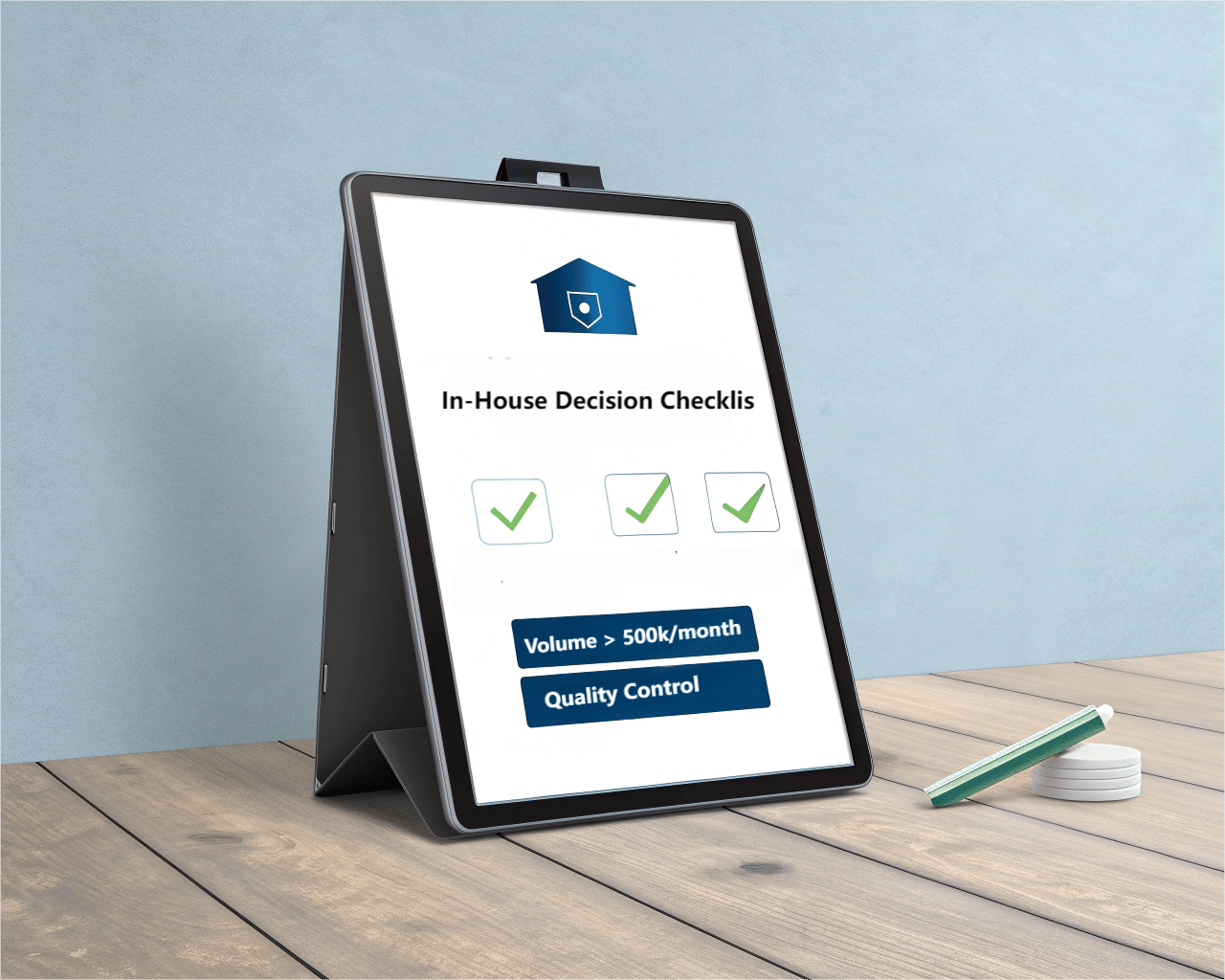
Dive Deeper: Your In-House Decision Checklist
After 16 years of guiding clients through this process, I've developed a simple framework to help them see the path forward. It's not based on emotion or fear, but on the real-world metrics of their business. I encourage you to sit down with your team and honestly answer these questions.
Your In-House Decision Checklist
Think of this as a scorecard. The more questions you answer with "This describes us," the stronger the case is for bringing your PET bottle manufacturing in-house.
| Factor | Stay with Outsourcing | Consider In-House | Strongly Consider In-House |
|---|---|---|---|
| Monthly Bottle Volume | Under 100,000 bottles. | 100,000 - 500,000 bottles. | Over 500,000 bottles. |
| Product Diversity | 1-2 standard bottle designs. | You want to test 1-2 new designs per year. | You need 3+ unique bottle shapes or plan frequent new launches and limited editions. |
| Need for Agility | Your product line is stable and rarely changes. | You feel constrained by MOQs and long lead times for small test runs. | Your business strategy relies on rapid innovation, seasonal products, and quick market response. |
| Quality Control Importance | Standard quality is acceptable. You trust your supplier. | You have experienced minor quality issues that caused concern. | Your brand's premium positioning is being damaged by inconsistent bottle quality. You need 100% brand control. |
| Supply Chain Stability | Your supplier is reliable and your demand is predictable. | You have faced stock-outs or delays that threatened a sales opportunity. | You are expanding into large retail channels where supply reliability is non-negotiable and lead times are critical. |
| Capital Availability | Startup capital is very limited and needed for marketing/sales. | You have secured a round of funding or have stable profits to reinvest. | You have access to capital (e.g., ~$200k+) for strategic equipment investments. |
| Technical Willingness | You want to focus solely on your product and brand, not manufacturing. | You have team members interested in learning the technical side. | You are committed to building a manufacturing competency and see it as a long-term competitive advantage. |
I use this exact logic when advising clients. My client in Bangladesh, at 30,000 bottles per month, is firmly in the "Stay with Outsourcing" column. For him, the blow molding machine investment makes no sense.
Conversely, my client in Thailand, with their massive volume, need for quality control, and position in a competitive market, is a textbook case for "Strongly Consider In-House." Our turnkey project was the logical and necessary next step for their growth.
This framework isn't about finding a single "right" answer. It's about building a convincing argument. When you see your brand's profile shifting from the left column to the right column, you'll know. The pain points of outsourcing will begin to outweigh the pain of the initial investment, and that is the moment to start planning your own production line. The first step is often a simple one: learning about the options, like understanding the different types of bottle blowing machines or the process for creating a custom PET bottle mold design.
Conclusion
Choosing between making or buying bottles defines your startup's path. Outsourcing is for early survival; in-house manufacturing is for scalable, long-term control and profitability. Use this guide to decide.
Frequently Asked Questions
1. What is the true break-even point for bringing bottle production in-house?
There's no single magic number, as it depends heavily on your negotiated price for outsourced bottles and the cost of your specific in-house equipment. However, a general rule of thumb I've seen over 16 years is that when you approach a consistent volume of 300,000 to 500,000 bottles per month, the financial math for in-house production starts to look very compelling. At this point, the savings on per-bottle cost begin to rapidly pay back the initial machinery investment.
2. Can I use the same blow molding machine for different bottle shapes and sizes?
Absolutely. This is one of the key advantages of in-house production. The blowing machine itself is highly versatile. The bottle's shape, size, and design are determined by the blow bottle mold. By simply changing the mold, which can take a few hours, you can switch production from a 500ml round bottle to a 1L square bottle on the same machine (within the machine's technical limits). This gives you incredible flexibility to expand your product line without buying a new machine for every design.
3. What are the biggest 'hidden costs' of setting up my own production line?
Beyond the main machine, the biggest costs that surprise new manufacturers are the auxiliary systems. You cannot run a blow molder without a robust high-pressure air compressor system and a dedicated chiller for the molds. Another often-underestimated cost is the need for a stock of essential spare parts and having a trained maintenance technician on staff or on call. These elements are critical for minimizing downtime.
4. How difficult is it to find and train a machine operator?
Finding an experienced blow molding operator can be challenging depending on your location. However, modern machines are becoming more user-friendly with intuitive touch-screen controls. The most common path, and one I facilitate in all my turnkey projects, is to train mechanically inclined members of your existing staff. A typical training period of 1-2 weeks on-site with an expert is usually enough to get a new team comfortable with day-to-day operations, quality checks, and basic troubleshooting.
5. If I have to outsource for now, how can I better control the quality of my bottles?
Even when outsourcing, you can take steps to improve quality control. First, provide your supplier with a "Quality Specification Sheet" that clearly defines acceptable standards for weight, dimensions, color, and defects. Second, request and approve a "golden sample" before every production run. Finally, for critical orders, consider hiring a third-party inspection service in the supplier's country to check the products before they are shipped. This adds a cost but can prevent a disastrously bad shipment from ever leaving their factory.
🔗 Learn More about Blow Molding Technology
-
Blow Molding – Wikipedia
A comprehensive overview of various blow molding processes, including extrusion, injection, and stretch blow molding. -
Injection Molding – Wikipedia
Important for understanding the production of preforms used in stretch blow molding. -
Stretch Blow Molding – Wikipedia
Explains how PET bottles are formed through axial and radial stretching processes. -
PET Bottle – Wikipedia
Background information on the materials and properties of typical PET bottles. -
Design of PET Bottles – Wikipedia
An introduction to the design considerations and geometry used in PET bottle manufacturing.
🔗 Related Pages on Our Website
-
Automatic Blow Molding Machines – iBottler
Discover our full range of customizable automatic PET bottle blow molding machines. -
Blow Bottle Mold – iBottler
Explore our precision blow molds designed for PET and PP bottles. -
Preform Mold – iBottler
Learn more about our high-precision preform molds suitable for various injection molding machines. -
PET Wide Mouth Jar Project Starter Guide: Equipment, Molds & Process Explained
-
Pros and Cons: Should You Choose PET Blow Moulding for Your Bottle Project?
-
Worried About Blow Mold Fit? We Have Mounting Dimensions for 80% of Blow Molding Machines Worldwide
-
Can One Semi‑Automatic Blow Molding Machine Produce All Bottle Sizes? Here’s Why Not
-
Why Do Krones Blow Molding Machine Users Come to Us for Their Molds?
-
Why Do PET Preforms Come in Different Colors? Function, Application, and Production Tips
-
How to Set Parameters for 600ml Bottles on a Semi-Automatic PET Blowing Machine?
-
From 3D Printed Samples to Production: How Can You Rapidly Validate Blow Mold Designs?
-
How to Choose the Right Preform Neck Size for Your PET Bottle Project
